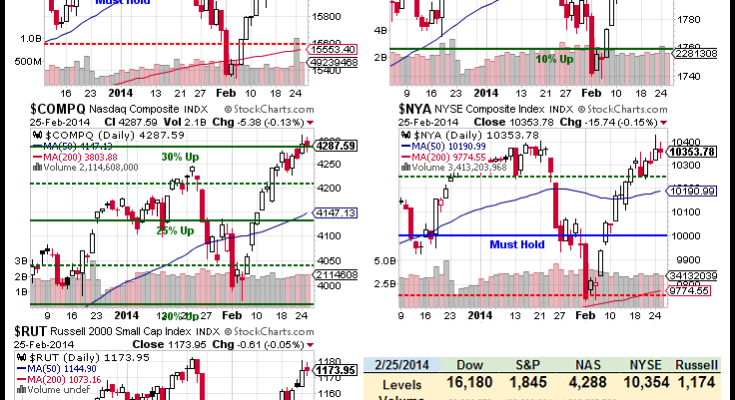
So close – and yet so far. Â
All but the Dow have fully recovered from the January drop and the Nasdaq is making up for it by going 50 points over the previous 4,250 high (1.2%).  Is it a clear indication of a breakout or a silly spike higher with heavyweights like NFLX, TSLA, GOOG and PCLN acting like 1999-style dot com stocks?
TSLA is priced at 100 times FORWARD earnings, NFLX about the same, Â PCLN (26) and GOOG (23) are relative bargains by comparison and AAPL (our trade of the year), with a market cap of $465Bn against $40Bn of earnings would seem like a great deal, by comparison (even if you ignore their $180Bn in cash), yet they have, so far, been sitting out the market rally at $520. Â
This is just what it was like in 1998 and 1999, when people who owned “sensible” stocks like IBM, GE, AT&T, McDonalds, Ford, etc. were punsihed while Webvan (the old Amazon), Microstrategy (survivor), WorldCom (the old MCI), Inktomi (the old Oracle), Lycos (the old Google), Pets.com (the old nothing), Broadcast.com (the old NFLX), etc were valued at 100x earnings and more (the average p/e for the Nasdaq in 1999 was 78 times earnings). Â

A contrarian investor would have done very well for themselves in the 2000-2003 collapse, but only if they survived the run-up!  That’s why I called for CASH!!! last week, not shorting, other than a few 500% hedges that are to be pulled with small losses if the indexes do manage to get over their previous highs (3 of 5, and it has to hold for 2 full days) of Dow 16,588, S&P 1,850, Nasdaq 4,250, NYSE 1,0406 and Russell 1,182. Â

If they can do that, we can get more bullish but, if they can’t – why should we?  Sometimes, the only winning move is not to play and this is a very good time not to be playing. Â
I THINK the market is not strong enough to get over this hump at this time. I THINK these high-flying momentum stocks are being used to mask a broader exit of the indexes by the Banksters, who cover their tracks with a string of upgrades to excite the Retail Investors while they privately urge their High Net-Worth clients to “diversify” out of equities (after they have dumped their own holding, of course). Â

